If ever there was proof that size really doesn’t matter it was Lloyd Triestino‘s Victoria. At 164.60 metres (540 feet) long and a little over 13,000grt she was a minnow compared to many of her contemporaries, especially those grand and opulent super liners plying the Atlantic trade. Nevertheless, in terms of external and internal design and character her impact and legacy was far-reaching, certainly exceeding those relatively modest dimensions.
The new ship was ordered as a replacement for the veteran sisters Helouan (named after a suburb of Cairo) and Vienna (originally Wien), which had maintained the Italy-Egypt service since 1911. The second ship betrayed Lloyd Triestino’s heritage, when commissioned the two ships sailed from the then Hapsburg governed port, under the Lloyd Austriaco house flag.
The decision to order just a single vessel was taken after considering several circumstances. First the Austro-Hungarian Empire’s defeat in 1918 robbed Trieste of its role as the principal conduit from Middeleurope to Africa and Asia. Having been ceded to Italy the great port found itself on the fringes of its newly adopted homeland, relegated in significance behind Genoa, Naples and Venice. Inevitably there was a consequential drop in passenger numbers. Furthermore the ship was ordered against a backdrop of economic uncertainty in the wake of the Wall Street crash and perhaps most significantly, technical advances allowed the prospective new liner to operate a 20.5 knot service speed, a full 3 knots faster than her quadruple expansion powered predecessors. Coupled with her greater size and capacity this allowed the solitary ship to accommodate almost the same annual passenger numbers as the earlier duo.
Unsurprisingly Lloyd Triestino commissioned the local Cantiere San Marco shipyard to build their new vessel. It was a propitious decision. Responsibility for the hull and external design of the new vessel was allocated to a talented young naval architect called Nicolò Costanzi, who had come to prominence creating Cosulich Line’s highly reputed Saturnia and Vulcania in the mid-1920s. The first keel plates of yard number 782 were laid on 3rd May 1930, forming part of a cellular double bottom which extended from the fore to the stern peak. From the rounded bow to the rakish cruiser stern the 540 ft long by 70 ft wide hull possessed a particularly fine entry at the waterline. As one of the first vessels to comply with the new SOLAS 1929 regulations, number 782 also incorporated eleven watertight compartments as well as the aforementioned double bottom.
To the backdrop of a watery winter sun, a large crowd gathered at San Marco on 6 December 1930 to witness Donna Carolina Ciano, wife of the incumbent Minister of Communications, bestow the name Victoria on the new ship (Alessandrina and Cleopatra had also been considered). Amidst customary cheers the svelte hull slipped down the ways and into the calm waters of the Adriatic.
Less than five months after that celebrated launch, on 30th April 1931, the completed Victoria left the yard and entered the large floating dry-dock at Pula, along the Istrian coast. A 1930 artist impression had provided a first glimpse of the new ship, sporting the company’s original black hull and funnel livery. However when Victoria finally emerged from the shipyard she looked quite different, introducing a new, fresh, more practical and pleasing all white livery, complemented by a blue sheer band and boot topping and buff coloured funnels, masts and cargo gear. Having completed preliminary trials Victoria sailed out into the Adriatic on 20th June for official speed runs. Original projections were that the new ship would achieve a maximum speed of around 21 knots, allowing some reserves over the 20.5 knot service speed. With excited, if apprehensive engineers in attendance, Victoria’s four 4,250hp two cycle CRA Sulzer 8ST68 engines (built at the local Fabbrica Macchine Sant’Andrea workshop) worked up to their maximum 18,600hp power output, turning her quadruple screws to achieve an astonishing 23.26 knots. Not only did this easily meet the yard’s contractual obligations but Victoria became the fastest motor liner afloat.
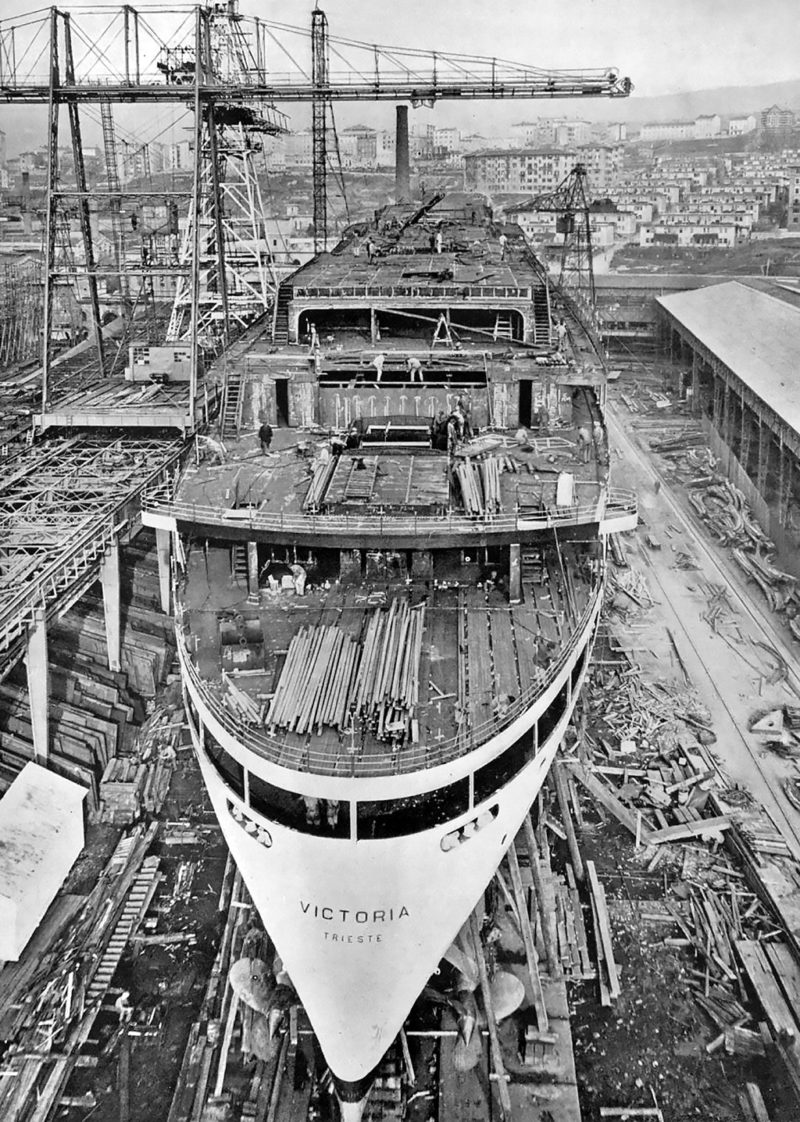
The following day Lloyd Triestino proudly took delivery of their new flagship. Externally she presented a singularly elegant and harmonious profile, with a subtly curved, glazed forward superstructure and gently tiered aft decks. A journalist invited to look over the vessel prior to her entry into service commented whimsically, “This ship is so sleek and subtle that she is clever at hiding her bulk, or, to be more precise, it is her designer, the engineer Nicolò Costanzi, who was able to conceive a living being whose visual impact is of movement and whose substance is comfort”.
Her two tapered funnels were bracketed between a mast situated above the bridge and a main mast aft, with two pairs of kingposts fore and aft to service the four cargo hatches. Like other liners of the era (notably Bremen and Europa, Rex and Conte di Savoia) the rake and position of the funnels and masts created the illusion of speed even when moored. Primarily because it contrasted with the brown hued lifeboats forward the most prominent superstructure feature was undoubtedly the lofty recess above the First Class Dining Salon. With its white walls and arched, stained glass windows, this aft portion of Boat Deck had an almost church like facade.
On 27th June 1931 Victoria embarked her first fare-paying passengers. There was an overall capacity for 666 passengers, with a strong emphasis on First (239 berths) and Second (245) class accommodation and facilities. Indeed Third (100) and Fourth (82) were crammed into the lower decks with shared public rooms, although all passengers were accommodated in cabins. Looking after them all was a crew of 254.
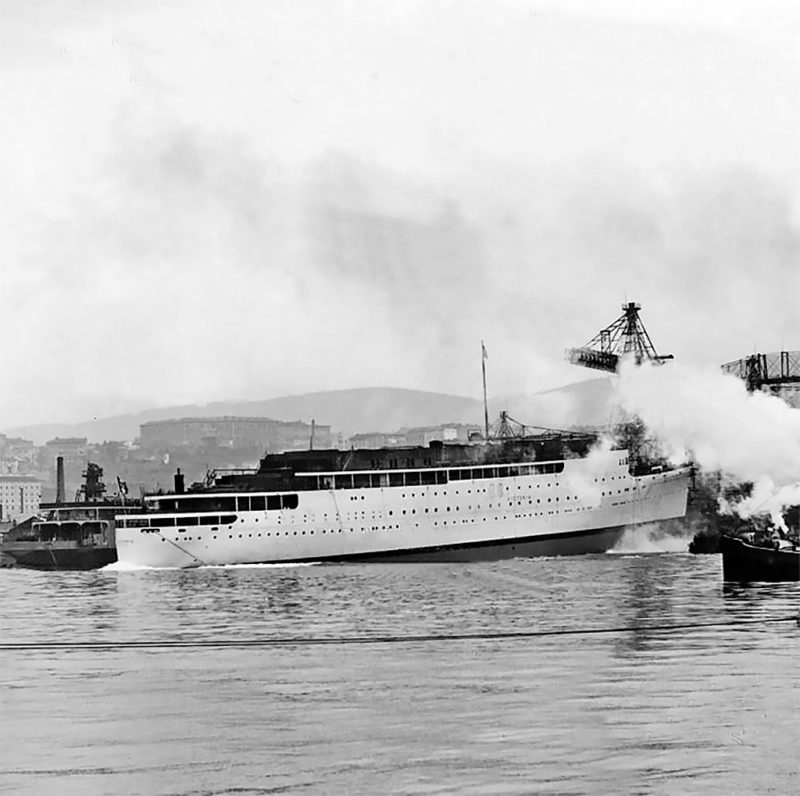
There were six passenger decks: Sports, Boat, Saloon, A, B and C. As they passed through the shell doors on A deck those fortunate First Class maiden voyagers encountered interiors of a uniquely modern style, the work of an eclectic mix of designers, including and coordinated by Gustavo Pulitzer Finali. Pulitzer’s approach to interior design was summed up in comments made to the same journalist quoted earlier. “No more is architecture imposed on the ship, no more faux palaces, no more fake structures. The architect must look for the harmony within the inner outfitting, without altering the spaces which are dictated by the structures of the ship herself. The effects which he can achieve in this way are endless and exquisite in all details, provided that he studies the most appropriate resources which each material offers for decorative expression.” Referred to as the ‘Littorian’ style, this synthesis of the ship’s structure with its interior décor was also advocated by Costanzi, Victoria proved to be just the first of several famous collaborations between the two men.
First Class passengers entered into a capacious vestibule on A deck (the first full length deck at the top of the hull), which together with the associated grand staircase was designed by the Palermo based Ducrot company. It featured an ornate palesandro wood mural by Maryla Lednicka. Ducrot were generally renowned for their historical themed ship interiors but Pulitzer’s influence clearly tempered any Baroque excess in Victoria’s case. Forward of the vestibule were First Class suites designed by the Viennese firm Portois et Fix (the only non-Italian designers employed). The majority of First Class cabins featured lounge areas and full tub baths that included both salt and fresh water hot and cold taps and many included folding beds, allowing the rooms to be easily converted from bedroom to day rooms. A deck was also a conspicuous example of the vertical class segregation that applied to almost all ships of the era. First Class occupied the most stable and vibration free central section (more cabins, some of which were interconnected were located just aft of the entrance vestibule), Third Class open deck space was on the exposed foredeck and the main Second Class public rooms (dining room, social hall and smoking room) were located towards the stern. The latter were almost as well regarded as their First Class equivalents, including works by such renowned designers as Gio Ponti and Augusto Cernigoi.
From their entrance vestibule First Class passengers ascended the Ducrot staircase to Saloon Deck, which as the name suggests was where that class’ principal public rooms were located. A broad open promenade ran down each flank, which was glazed forwards where it seamlessly morphed into the full width Veranda room. The staircase opened directly into the central main Sala delle feste lounge or ‘social hall’, with its deep wooden pillars and beams contrasting with white ceiling panels and ornate inlaid dance floor.
As an aside, the sculptor Marcello Mascherini, whose later figurative work adorned many ocean liner rooms, was commissioned to produce two busts for the social hall, Il Duce (of Mussolini) and Il Re (of King Victor Emmanuel III). When Mussolini first saw his portrayal in a June 1931 edition of Il Piccolo newspaper, he was clearly put out and insisted it be removed from the ship. There ensued a stream of correspondence, with Mascherini ultimately informing Lloyd Triestino management that His Excellency would surely be happy with the bust if he could see it correctly. Doubtless to everyone’s relief a final telegram was sent to the company in mid-August advising that the bust could indeed be retained.
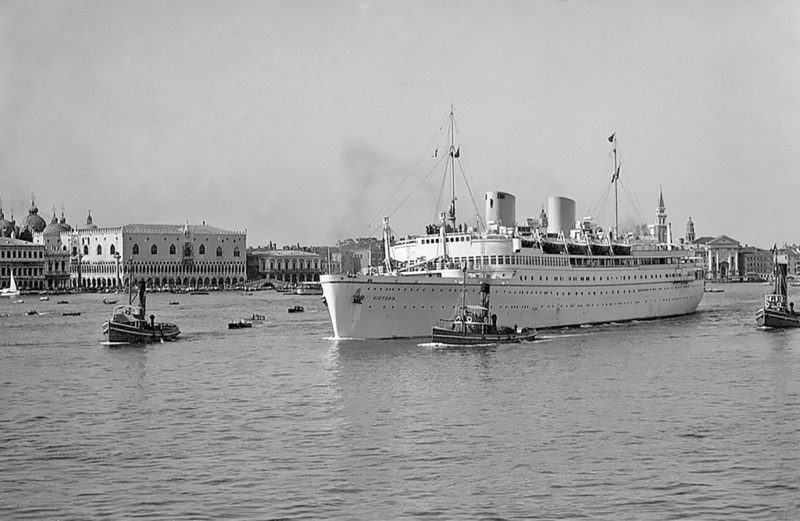
Forward of the social hall and accessed by a gallery to port or the card room to starboard (sandwiching the forward funnel casing) was arguably Pulitzer‘s pièce de résistance, the elliptical smoking room. From its bright, brass and chrome fronted bar to its polished marble fireplace, the entire room was an elegant, streamlined manifestation of its designer’s principles. The room was enhanced with bright polychrome glass panels by Pietro Chiesa and various works of art, including a parchment profile of the ship by Augusto Cernigoj and Lednicka’s copper and silver wall hung figure of ‘Victory’.
Ahead of the smoking room and indeed furthest forward on Saloon Deck was the full width Veranda Room offering 180° sea views over the bow and flanks via wraparound fenestration. The light beige walls and ceiling and vivid coloured geometric patterned rubberised flooring (supplied perhaps inevitably by Pirelli), together with a variety of green hued fabric furniture gave this room a particularly light and bright feel.
Just aft of centre and broadly in line with the aft funnel the open deck narrowed to accommodate the largest (19m x 16m) and most versatile room onboard. Nominally the First Class Dining room, the two deck high room was devoid of pillars, with the ceiling suspended from a series of arched roof beams. Lighting was provided by more Chiesa coloured stained glass panels, which were back-lit at night, and vases held aloft by two elaborate mermaid sculptures from Libero Andreotti. The end walls featured Egyptian style depictions of fishing and hunting scenes.
As well as being the main dining venue the room also hosted recitals and periodically doubled as a grand ballroom. Perhaps its most noteworthy feature, to the doubtless relief of those onboard, was felt rather than seen. Concealed on the open deck aft, having been constructed in England, the American Carrier company provided the first automatic air-conditioning plant system installed on a ship.

Witnessed by a huge crowd of onlookers lining the waterfront, Victoria edged away from Trieste’s impressive maritime station on that late June afternoon in 1931 and headed for Alexandria via Venice and Brindisi. She settled into the new service immediately and was easily the most impressive vessel on the Eastern Mediterranean route. However economic circumstances would soon mean a significant change of role.
In January 1932, as a response to the precarious global economic situation and neatly tying in with the Fascist doctrine of state ownership, various private shipping companies were absorbed into a new state funded conglomerate, Società Italia Flotte Riunite, commonly known as the Italian Line. Consolidating services and eliminating undue competition made eminent sense but had wide ranging consequences including the disappearance of several famous lines. Lloyd Triestino was fortunate, having previously been a subsidiary of Lloyd Sabaudo it retained its name and a degree of autonomy in the restructured arrangement. It also gained new ships from the remnants of the former lines. Amongst the latter were SITMAR’s (until then a subsidiary of the great NGI) Esperia and Ausonia, former direct rivals of Victoria on the Italy-Egypt service. They would be retained on the intra-Mediterranean service whilst the company flagship headed East to India and beyond.
Her new employment was on the express service from Genoa to Bombay calling at Naples, Port Said and Aden en route. Already famous and well reputed for her speed, appointments and service this new route cemented the ship’s exotic, enchanting and legendary status. She became known as ’The ship of Maharajahs’, and it was no empty advertising slogan. Amongst the famous passengers photographed on her open decks or fashionable public rooms were the Princess of Bhapole, Raja of Biniji and Maharajah of Jaipur. To the chagrin of P&O and the British Government she also became a firm favourite of Raj administrators and diplomats, who ignored calls to boycott ‘The Fascist ship’.
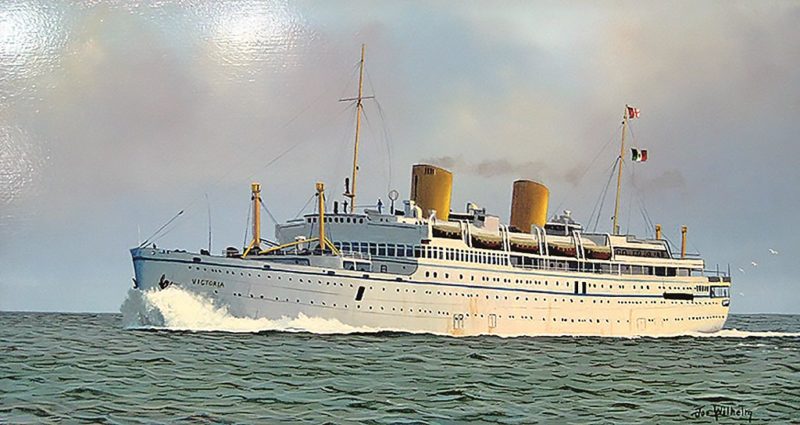
That enviable reputation was partially founded on her speed and style but also on the high standard of cuisine and the warmth and dedication of her Italian crew. Facilities were enhanced in 1935 by the addition of a large outdoor swimming pool on boat deck. This provided further respite from the intense tropical heat. In October that year Victoria returned to her old destination port of Alexandria on her way to and from India, supplementing Esperia’s sailings after the tragic loss of Ausonia to fire. Showing her innate flexibility Victoria briefly switched itinerary at the end of December 1935, sailing on the 29th from Venice to Shanghai as a substitute for the larger Conte Rosso which was being refitted.
Having clearly proven her viability on the route she had only returned to the Genoa-Bombay service for two months before it was extended to Shanghai. In October 1936 Victoria found herself once more at Trieste, in front of the company’s grandiose offices having been selected to host a grand dinner and gala evening to celebrate Lloyd Triestino’s centenary.
Thereafter she was permanently shifted to the Far East trade, sailing from Genoa to Naples, Port Said, Aden, Bombay, Colombo, Singapore, Manila, Hong Kong and Shanghai. Her sumptuous reputation continued to grow, fashioned in part by a lavish advertising campaign co-ordinated by Bruno Astori and featuring beautiful depictions of the ship and her interiors by renowned artists like Giuseppe Riccobaldi. The magnificent artwork was matched by equally honeyed words:
“The great express Italy-India-Far East will give you happy dreams of countries where life is colourful and the variety, the unexpected stories will recall the excitement of youth. One beautiful morning, you embark on the immaculate and streamlined Victoria, alive and breathing like a young creature, and at dawn on the ninth day you will arrive at Bombay. Does it not seem like a dream? All the East from Port Said to Shanghai is yours in about twenty days. You can leave the ship, happy and invigorated by the voyage, at Massawa, Djibouti, Aden, Colombo, Manila or Hong Kong. If you are attracted to Japan, you can transship at Shanghai, if you are going to Siam or Singapore two perfect connections await you.”
From May 1937 Victoria formed the smallest unit of a quartet providing fortnightly sailings between Italy and China, in conjunction with three of the former Lloyd Sabaudo Conte. All seemed settled but Shanghai was about to become the epicentre of an often overlooked conflict (from a Western perspective) and one of the bloodiest battles of all time, later referred to as ‘Stalingrad on the Yangtze’. The second Sino-Japanese war officially started in July 1937 although there had been simmering tension since the Japanese invasion of Manchuria six years earlier. The Battle of Shanghai started on 13th August and under the command of Captain Angelo Capurro Victoria was caught in the initial melee. The ship carried 600 refugees including Italians, Germans, Britons, Swiss, Spaniards & Filipinos from Shanghai to Hong Kong, Singapore and beyond. Despite dogged resistance the Japanese ultimately prevailed, taking control of the city in early November. This prompted many competitors to suspend sailings but Lloyd Triestino continued to offer passage (for safety anchoring at nearby Woosung rather than entering the port of Shanghai) and carried many evacuees from the fighting and its aftermath to Hong Kong and Europe.
Victoria maintained her sailing schedule throughout 1938, with additional calls at Manila and servicing the Adriatic ports of Brindisi, Venice and Trieste both in and outbound from Naples and Genoa. ‘The dove of the Orient’ as she was affectionately dubbed continued to carry the rich and royalty between Europe and Asia, although as 1939 progressed her passenger lists included an increasing number of German Jews. Despite the formal political and military bonds between Italy’s fascist government and its German Nazi counterpart, cemented in the ‘Pact of Friendship and Alliance’ (generally referred to as ’The Pact of Steel’). Italy and Italian ships were instrumental as a conduit through which fleeing Jews escaped persecution in their homeland. In May, the same month that the Pact was signed in Berlin, Victoria carried 300 escaping Jews to Shanghai, followed by 250 more in July and finally 300 in that fateful September.

Pragmatism dictated that Italy remain neutral in the ensuing conflict between Britain, France and Germany that erupted in September 1939. The country was ill prepared for war having stretched its military and economic resources during successive campaigns in Abyssinia, Spain and Albania. Victoria and the rest of the Italian merchant fleet therefore maintained their original services despite the tense international situation, initially at least.
Nevertheless the Allied protagonists were suspicious of the Italian ships, as it transpired with some justification. On 2nd November 1939, sporting vivid neutrality markings in the form of large Italian flags on each white flank, Victoria called at Bombay. The British authorities combed the ship following allegations that she was carrying illegal materials and letters and indeed the tip-off proved correct. Amongst the mail bags hoisted on board they discovered letters from the wife of the local Nazi Party leader detailing local troop and naval movements. This proved to be Victoria’s final commercial voyage. On her return to Genoa on 20th November she was laid up.
When German forces unleashed their successful Blitzkrieg offensive against France and the Benelux nations in the spring of 1940 the European situation changed dramatically. Ignoring the advice of his generals and ministers Mussolini entered the fray on 10th June 1940, believing Italy could make swift territorial gains against a beleaguered France and overstretched Britain in Europe, Africa and the Middle East before the Allies sued for peace.
As Italian forces were mobilised in advance of the formal declaration Victoria sailed with a first consignment of troops from Genoa to Bari on 1st June. On the 25th she departed Naples with 437 soldiers and almost 3,000 tons of equipment and supplies bound for Libya, in preparation for the impending invasion of Egypt. By mid-July Victoria returned to Genoa where she remained laid-up for the rest of the year.
Early in 1941 Victoria was pressed into action once more, departing Naples on the 22nd January sporting drab grey splinter camouflage for the first of eight return trooping voyages to Tripoli. She was just one element of the large and fast (14 to 18 knot) convoys which carried consignments of the six Italian divisions sent to reinforce the Italian 10th Army and which in conjunction with the German Afrika Corps, under the overall command of Erwin Rommel, swept the British and Australian forces back into Egypt.
On 26th August 1941 Victoria arrived at the Taranto naval base for a much needed refit. This included maintenance and repair of an engine which had broken down in the course of an earlier voyage and changes to her accommodation to facilitate increased troop capacity. After completion of the work Victoria slipped out of port on 22nd January 1942 carrying 720 officers and men of the 12th Bersaglieri Regiment and 405 German troops.
Having rendezvoused with three other transports she was joined by a significant naval escort comprising elements of the 7th Cruiser Division (Aosta, Attendolo and Montecuccoli) and the 13th Destroyer Squadron to form convoy T48. The Italians were naturally wary after having lost two troopships (the Italian Line’s Oceania and Neptunia) to a single submarine attack (HMS Upholder) the previous September. As the convoy headed south for Tripoli twelve German Junkers 88 aircraft were dispatched to provide air cover.
On the evening of the 23rd January the convoy was in the Gulf of Sirte, approaching the Libyan coast when it was attacked by Bristol Beaufort aircraft of the R.A.F.’s number 39 squadron. They had taken off from Berka airfield in northern Cyrenaica region. Despite the heavy escort one of the Beaufort’s successfully launched a torpedo that struck Victoria at about 18:45. She took on water immediately and the order was given to abandon ship. In the course of the evacuation she was struck by a second torpedo, launched from a Fairey Albacore of 826 Squadron Fleet Air Arm.
Victoria sank in a position 33º30’N, 17º40’E around 03:00 the following morning having remained afloat long enough to allow 1,046 of the 1,400 souls onboard to be rescued. Her destruction was a major success for the Allies, both in terms of eliminating her troop carrying potential and the broader message it sent, regarding the vulnerability of Mediterranean Axis troop carriers. For the Italians it was a devastating blow, robbing the country of a fast troop transport and indeed the broader shipping community of one of the finest passenger ships of all time. It was yet another example of the asinine consequences of war.

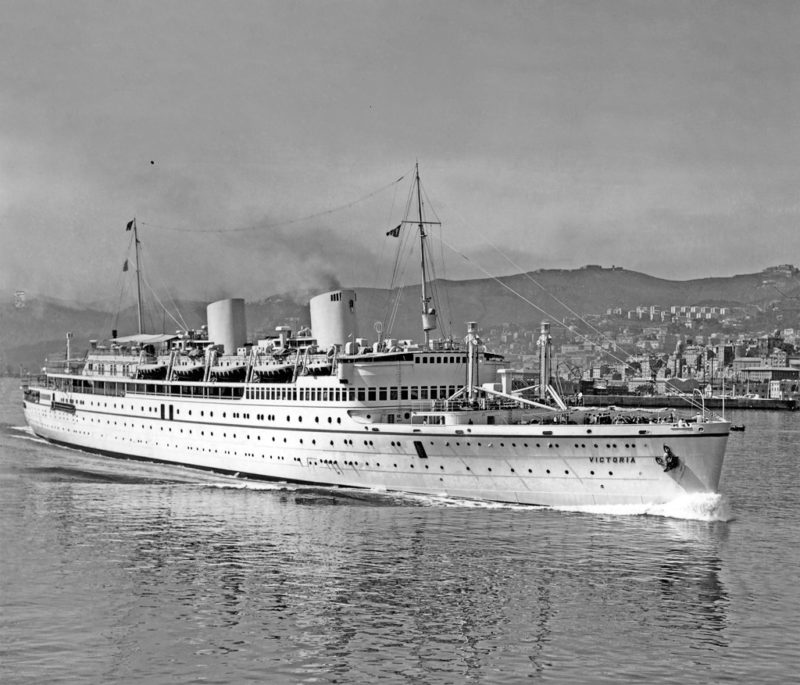
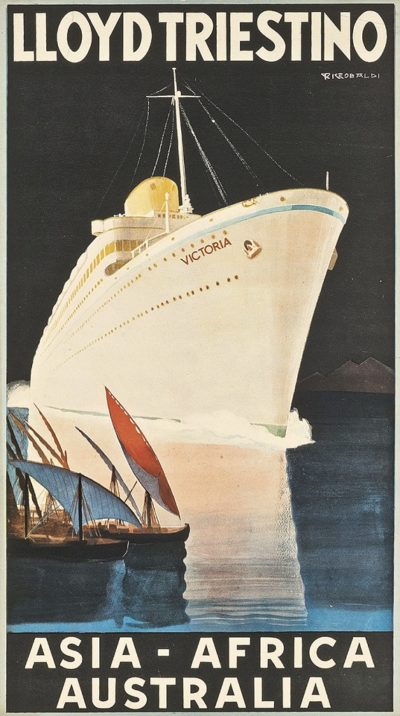
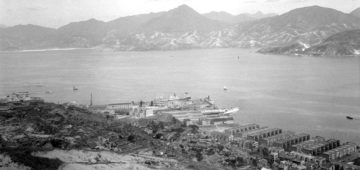



Comments
Sorry, comments are closed for this item